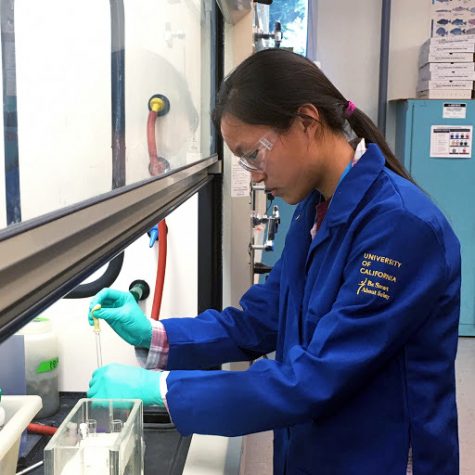Science internship introduces high schoolers to research
August 30, 2019
Whether they are traveling all over the world or are at home studying for the August SATs, Harker students do a variety of different activities over the duration of summer vacation. For sixteen high schoolers in particular, their break was spent at the Summer Internship Program (SIP), an eight-week long research internship opportunity at the University of California, Santa Cruz (UCSC).
Based in a professional laboratory setting, SIP matches each intern with a mentor from the university who is currently working on a project that aligns with that student’s interests. With topics ranging from astrophysics to biology, the different fields allow high schoolers to pursue their passion for STEM and gain hands-on experience with tackling real-world research problems.
Dr. Raja GuhaThakurta, director of SIP and UCSC astronomy professor, believes that this is a summer program that provides high school students with the opportunity to not only learn about critical thinking in the context of open-ended research but also about sharing the outcomes of one’s project in a formal presentation.
“At the end of the summer, we ask [students] to step back from where they’ve reached [in their research] and explain [their project] to an audience who is not on their level of understanding,” GuhaThakurta said. “That’s a very difficult thing to do with something highly technical that you’re completely embedded in — it takes a tremendous degree of sophistication and communication.”
For junior Allison John, her project “Braingineers” gave her the chance to learn about these important skills through the process of designing small microscopes that monitor the growth of groups of stem cells and using computer vision to implement image analysis techniques.
“I was very excited to contribute to something that so many people had put so much effort into,” Allison said. “[This experience] taught me to keep trying things when it wasn’t working and to keep pushing and persevering instead of just giving up.”
Also providing students with the option of living in the dorms at UCSC, SIP resembles a college atmosphere, where at the end of a work day, interns can enjoy spending time with their peers outside of the lab.
“I stayed in the dorms for a week, where I got to interact with some other SIP interns,” sophomore Alice Feng said. “Everyone had their own project, and we were all excited and interested in each other’s projects to get a better view of the [research] that is happening at the university.”
SIP began when upper school science department chair Anita Chetty sent three Harker high schoolers to UCSC in the summer of 2009 to do research under the mentorship of GuhaThakurta. Initially an opportunity for a couple students to gain laboratory experience, it gradually became a program for teenagers all over the country to immerse themselves in a unique research project for the entire summer.

Teresa Cai (10) conducts a chemistry experiment under a fume hood at UCSC. Sixteen Harker students participated in the Summer Internship Program.
“It didn’t have a name — it wasn’t called SIP, and we didn’t even think it was a program. It was just a little experiment that Ms. Chetty and I were trying,” GuhaThakurta said. “We decided to try again next year, and there were 15 students. It kept growing like that: in the following year it was 29, then 43, 51, 68, 104, 142, 157, 165 and now 180.”
While SIP itself may have expanded in size over the last decade, one thing that hasn’t changed is the program’s objective to give students the chance to thoroughly explore a niche research topic that they are interested in and can continue pursuing in the future. Bryan Wang (12), along with his partner Rishi Dange (12), participated in the program for the second year in a row this year so that they could continue working in the same lab and further investigating their research project.
“I think all interns leave with a much better understanding of the actual research process and gain experience delving deep into a topic, which is more valuable and more significant than the actual content matter,” Bryan said. “Leaving SIP, I’ve learned how to look into problems and think about them holistically, outside of a purely academic setting.”
GuhaThakurta expresses this same sentiment, asserting that research provides high schoolers with opportunities that cannot be found in an average class curriculum.
“The world is filled with problems that need to be solved and haven’t yet been solved. If you’re only solving problems that others have already solved, we’re not doing our students any great favor because that’s not how the real world operates,” GuhaThakurta said. “I’m not saying that [research] is going to be easy, but it’s never good for human beings to not be challenged. If we’re in our comfort zone all the time, we’re never going to grow.”


















![“[Building nerf blasters] became this outlet of creativity for me that hasn't been matched by anything else. The process [of] making a build complete to your desire is such a painstakingly difficult process, but I've had to learn from [the skills needed from] soldering to proper painting. There's so many different options for everything, if you think about it, it exists. The best part is [that] if it doesn't exist, you can build it yourself," Ishaan Parate said.](https://harkeraquila.com/wp-content/uploads/2022/08/DSC_8149-900x604.jpg)




![“When I came into high school, I was ready to be a follower. But DECA was a game changer for me. It helped me overcome my fear of public speaking, and it's played such a major role in who I've become today. To be able to successfully lead a chapter of 150 students, an officer team and be one of the upperclassmen I once really admired is something I'm [really] proud of,” Anvitha Tummala ('21) said.](https://harkeraquila.com/wp-content/uploads/2021/07/Screen-Shot-2021-07-25-at-9.50.05-AM-900x594.png)







![“I think getting up in the morning and having a sense of purpose [is exciting]. I think without a certain amount of drive, life is kind of obsolete and mundane, and I think having that every single day is what makes each day unique and kind of makes life exciting,” Neymika Jain (12) said.](https://harkeraquila.com/wp-content/uploads/2017/06/Screen-Shot-2017-06-03-at-4.54.16-PM.png)








![“My slogan is ‘slow feet, don’t eat, and I’m hungry.’ You need to run fast to get where you are–you aren't going to get those championships if you aren't fast,” Angel Cervantes (12) said. “I want to do well in school on my tests and in track and win championships for my team. I live by that, [and] I can do that anywhere: in the classroom or on the field.”](https://harkeraquila.com/wp-content/uploads/2018/06/DSC5146-900x601.jpg)
![“[Volleyball has] taught me how to fall correctly, and another thing it taught is that you don’t have to be the best at something to be good at it. If you just hit the ball in a smart way, then it still scores points and you’re good at it. You could be a background player and still make a much bigger impact on the team than you would think,” Anya Gert (’20) said.](https://harkeraquila.com/wp-content/uploads/2020/06/AnnaGert_JinTuan_HoHPhotoEdited-600x900.jpeg)

![“I'm not nearly there yet, but [my confidence has] definitely been getting better since I was pretty shy and timid coming into Harker my freshman year. I know that there's a lot of people that are really confident in what they do, and I really admire them. Everyone's so driven and that has really pushed me to kind of try to find my own place in high school and be more confident,” Alyssa Huang (’20) said.](https://harkeraquila.com/wp-content/uploads/2020/06/AlyssaHuang_EmilyChen_HoHPhoto-900x749.jpeg)






